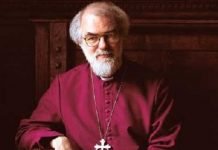A survey by The Times of 30 Church of England Cathedrals found that for many, congregations this Christmas were even higher than pre-pandemic levels and some cathedrals even had to turn people away because the pews were too full.
Average attendance at Christmas services was around 7-8,000 and was boosted by live streaming on YouTube where sometimes nine times as many people tuned in – in Norwich, their Christmas Eve procession service saw a 16,000 views on YouTube.
Salisbury and Gloucester had to turn people away because the pews were full, and several others said they were at full capacity.
The Dean of St Albans and the chair of the Association of English Cathedrals, the Very Revd Jo Kelly-Moore said:
“Cathedrals across the land were delighted to host thousands of people of all ages to their services across the Advent and Christmas seasons, many returning to and in some instances exceeding pre-pandemic attendance numbers.
“All this is part of the central place that Cathedrals hold in the cities and dioceses they serve, and is undoubtedly a result also of the increasingly varied ways in which our Cathedrals are committed to offering people of all faiths and none the chance to engage with their stories.”
Read The Times article in full here.
Cathedrals turn the tide as worshippers flock back to the pews
In the darkest days of the first pandemic lockdown, Salisbury Cathedral had to turn worshippers away, as church doors were closed on government orders, forcing it to lie empty. At Christmas last month, it had to turn 100 away as its pews were packed to full capacity.
The Christmas Eve carol service at Lincoln Cathedral “reached full capacity for the first time in several years”. Gloucester Cathedral was also full to its limit for its two carol services and also “unfortunately had to turn people away”, while Worcester Cathedral reported a “record Christmas” for attendance.
The Dean of Lichfield, the Right Rev Jan McFarlane, said: “Our experience this Christmas leads us to conclude that we shouldn’t be nailing down the lid on the Church of England’s coffin any time soon.”
Amid fears that the pandemic has accelerated the Church of England’s slide towards “extinction”, data obtained by The Times suggest that reports of its death may have been exaggerated, with cathedrals providing a beacon of hope.
Asked for their Christmas attendance data, Anglican cathedrals have reported figures that were not only up on 2022, 2021 and 2020, as congregations recover after the pandemic, but were in many cases even higher than those seen in 2019, the last normal Christmas before Covid-19 hit.
Thirty out of 42 cathedrals provided figures, with 24 seeing congregations rise from 2022 to 2023. Of 26 who provided pre-pandemic data, 13 saw congregations in 2023 that were even higher than in 2019, and 14 if you count those watching online on live streams introduced during the pandemic. At Canterbury Cathedral, 8,044 people attended in person over Christmas, up from 7,264 in 2019, but a further 67,746 watched live on YouTube compared to none in 2019.
At Ripon Cathedral, they had to seat worshippers in side-chapels with “no view at all” for the first time, watching on new screens. Ripon saw 4,365 attend in 2019. This fell to 1,105 in 2020 but bounced back higher to 6,094 in 2023.
“We were busier than expected, which we were delighted by,” said the dean, the Very Rev John Dobson. “We were seating people in parts of the cathedral where they haven’t sat before. We have never ticketed services, but that is something we’ll consider when planning for next Christmas.”
Salisbury Cathedral was back to 97 per cent of 2019 levels and would have been higher, but had to turn 100 away from three full advent services.
Cathedrals are special cases due to their greater size, resources and their city-centre locations, while Christmas is the most popular time for churchgoing. However there were signs of improving attendances in parishes, as well as signs the Christmas influx could be continuing into January.
“Here at St Albans Cathedral we have higher January service attendances so far than last year and much higher visitor footfall,” said the dean, the Very Rev Jo Kelly-Moore. “Many parish churches are reporting the same increases over Christmas as they too have engaged with their communities creatively. All this offers great encouragement as we welcome new people and grow back from the impact of the global pandemic.”
Attendance across the church has been declining slowly but steadily for decades. Sunday attendances fell from 1.2 million in 1986 to 690,000 in 2019. There are fears the pandemic may have “deepened” the decline, with many failing to return when churches reopened.
Attendances fell to 272,300 in 2020. They recovered to 509,000 in 2021, but only reached 549,000 by 2022. The pre-Covid trend suggests it should have been 653,000.
An early analysis of 2023 figures from Oxfordshire shows they were still 16 per cent down on 2019 — double the 8 per cent fall expected. If echoed nationwide, it would mean the church now has 61,000 fewer worshippers because of the pandemic.
The Rev Dr David Goodhew said this shows the church is “moving beyond decline and toward extinction”, particularly due to a 23 per cent fall in the number of children.
He said the cathedral figures were “very interesting”, but noted they are “much better resourced than parish churches” and account for only 3 per cent of the church’s worshippers. Even before the pandemic, cathedrals saw Christmas attendances increase between 2017 and 2019, though Sunday attendances were falling.
He said of the post-pandemic bounceback across the church: “My gut feeling is that growth could continue, but it would require sustained work.”
McFarlane said: “Our volunteer chaplains are reporting many conversations with visitors looking for some sort of sense and meaning in a world which feels increasingly insecure and frightening.”
Asked whether this could lead to a reversal of fortunes for attendances, she said: “As a church we believe in resurrection.”



